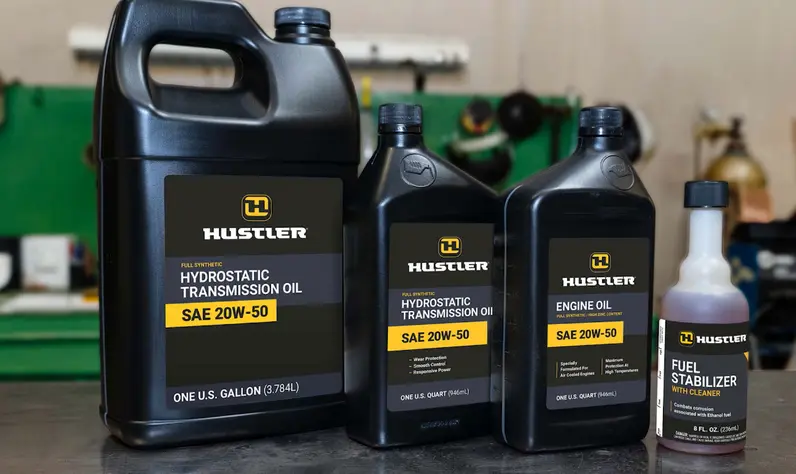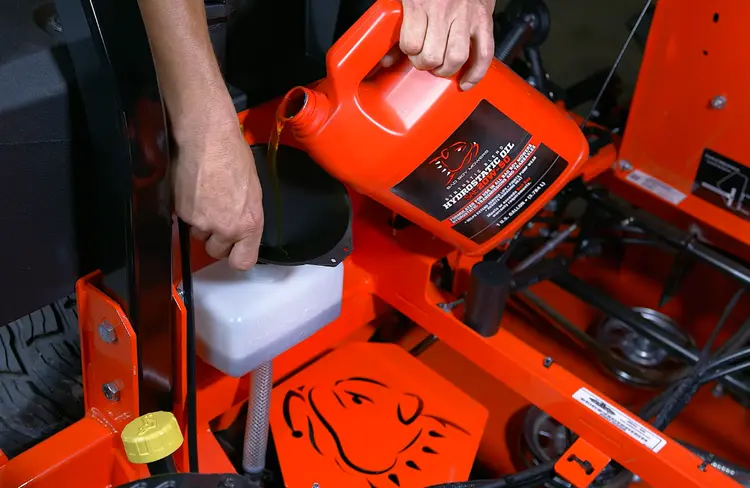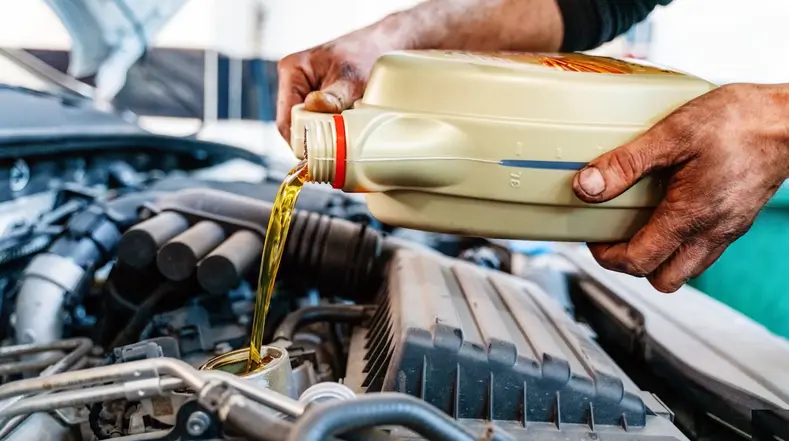No, you should only use oil that is specifically formulated for use in hydrostatic transmissions. Using 20W50 in a hydrostatic transmission may cause damage and decrease performance.
Hydrostatic transmission oil is designed to withstand gear lubrication to a much greater extent than motor oil. This means that dedicated transmission oil has a superior ability to maintain its original viscosity and provide more reliable wear protection over the long term.
Therefore, it is important to use the recommended oil for optimal performance and to avoid any potential damage to your hydrostatic transmission.
Understanding Hydrostatic Transmissions
Hydrostatic transmissions work by using fluid pressure to transfer power from the engine to the wheels. Choosing the right oil is crucial for these transmissions because it ensures proper lubrication and heat dissipation. The oil used in hydrostatic transmissions is specifically designed to withstand the high pressures and temperatures that occur in these systems.
It has superior viscosity retention and wear protection characteristics compared to motor oil. Using motor oil rather than the recommended hydrostatic transmission fluid can lead to premature wear and potential damage to the transmission. Therefore, it is important to use the correct oil, such as a 20W50 hydrostatic transmission fluid, to maintain the performance and longevity of your hydrostatic transmission.

Credit: www.amazon.com
The Role Of Oil In Hydrostatic Transmissions
Using the correct oil viscosity is crucial for the optimal performance of a hydrostatic transmission. Oil plays a vital role in maintaining the transmission’s functionality and preventing wear and tear. If the wrong oil is used, it can lead to various issues.
For instance, using 20W50 in a hydrostatic transmission can negatively impact its performance. The transmission may experience increased friction, reduced lubrication, and even premature failure. It is essential to consult the manufacturer’s recommendations or the equipment manual to determine the appropriate oil viscosity for the hydrostatic transmission.
By using the recommended oil, you can ensure that the transmission operates smoothly, with proper lubrication and a longer lifespan. It’s important to remember that hydrostatic transmission oil is specifically designed to withstand the unique demands and pressures of the system, providing reliable wear protection and maintaining viscosity over time.
Choosing The Right Oil For A Hydrostatic Transmission
Choosing the right oil for a hydrostatic transmission is crucial for its smooth functioning and longevity. There are several factors to consider when selecting oil for a hydrostatic transmission. First, you need to understand the recommended oil specifications for different hydrostatic transmissions.
Each transmission may have different requirements, and it’s important to adhere to these specifications to ensure optimal performance. Another factor to consider is the compatibility of different oils with hydrostatic transmissions. Some oils may not be suitable for use in hydrostatic transmissions, and using the wrong oil can lead to damage and malfunction.
It’s important to use dedicated transmission oil that can withstand gear lubrication and provide reliable wear protection. In conclusion, always use the recommended oil that is specifically formulated for hydrostatic transmissions to ensure the best performance and longevity.

Comparing 20W50 Oil With Other Options
The use of 20W50 oil in a hydrostatic transmission comes with its own set of pros and cons. When comparing 20W50 oil with dedicated hydrostatic transmission fluids, there are a few things to consider. While 20W50 oil may be more readily available and possibly more cost-effective, it may not provide the same level of performance and protection as dedicated transmission fluids.
Case studies and testimonials from users who have used 20W50 oil in their hydrostatic transmissions can give us valuable insights into their experiences and whether they encountered any issues or noticed any improvements in performance. It’s important to remember that using the recommended fluid is always the best practice to ensure optimal performance and longevity of your hydrostatic transmission.
Tips And Best Practices For Using 20W50 In A Hydrostatic Transmission
Using 20W50 oil in a hydrostatic transmission requires following proper procedures to ensure optimal performance. When adding or changing the oil, it is important to avoid common mistakes that can negatively impact the transmission. Maintenance tips, such as regular oil checks and filter replacements, will help to maintain the quality of the oil and extend the lifespan of the transmission.
It is crucial to use oil that is specifically formulated for hydrostatic transmissions to prevent damage and maintain the transmission’s efficiency. 20W50 oil is designed to withstand the demands of gear lubrication and provides superior viscosity and wear protection. By following these tips and best practices, you can ensure the smooth operation and longevity of your hydrostatic transmission when using 20W50 oil.
What is the best oil for hydrostatic transmission?
The best oil for a hydrostatic transmission is typically the one recommended by the manufacturer of the transmission or equipment. Manufacturers base their recommendations on extensive testing to ensure optimal performance and longevity. Commonly, specific hydrostatic transmission fluids or universal tractor transmission oils (UTTO) are recommended. These oils are formulated to handle the demands of hydrostatic systems, providing the necessary anti-wear, anti-foam, and friction-reducing properties. However, it’s crucial to always check the equipment’s user manual or contact the manufacturer for precise recommendations.

Can I use 20W-50 in my transmission?
Whether 20W-50 can be used in a transmission depends on the type of transmission and its design specifications. For hydrostatic transmissions, while 20W-50 might be used under certain conditions or for particular models, it’s not universally recommended. Always refer to the user manual or the manufacturer’s guidelines. For other types of transmissions, such as those in automobiles, the viscosity and properties of 20W-50 might not be suitable. It’s vital to use the correct oil to prevent potential damage and ensure optimal performance.
Is hydrostatic transmission oil the same as motor oil?
No, hydrostatic transmission oil and motor oil are not the same. While they might share some base characteristics, their formulations differ based on their intended applications. Motor oils are designed primarily to lubricate internal combustion engines, and they possess additives that handle byproducts of combustion and the specific demands of an engine. Hydrostatic transmission oils, on the other hand, are designed to meet the needs of hydrostatic systems, which include power transmission under varying loads and speed conditions. These oils often have different anti-wear, anti-foam, and friction-modifying additives compared to motor oils.
Can you use hydraulic fluid in a hydrostatic transmission?
In some cases, yes, hydraulic fluid can be used in a hydrostatic transmission. Many hydrostatic transmissions actually use a type of hydraulic fluid because they operate on the principle of hydraulic power transfer. However, not all hydraulic fluids are suitable for all hydrostatic transmissions. It’s crucial to ensure that the hydraulic fluid chosen meets the specifications of the transmission, particularly concerning viscosity, anti-wear properties, and temperature stability. As always, it’s essential to refer to the manufacturer’s guidelines or the equipment’s user manual before making such a decision.
What is the primary purpose of 20W50 oil in hydrostatic transmissions?
20W50 is a high-viscosity oil that provides excellent lubrication and wear protection. When used in hydrostatic transmissions, it can offer stable operation, especially in high-temperature environments, ensuring the system remains efficient and prolonging the transmission’s lifespan.
Can using 20W50 oil damage a hydrostatic transmission?
While 20W50 can provide benefits in certain circumstances, it’s essential to check the manufacturer’s recommendations. Using an oil that’s not recommended can result in reduced efficiency, premature wear, or, in worst cases, damage to the transmission components.
What are the main differences between 20W50 and standard hydrostatic fluids?
Standard hydrostatic fluids are specifically formulated for hydrostatic transmission systems, providing the necessary anti-wear, anti-foaming, and friction-reducing properties. 20W50, on the other hand, is a multi-grade engine oil, primarily designed for engines. Its viscosity and other properties might not align perfectly with what a specific hydrostatic transmission requires.
Are there specific hydrostatic transmission brands that recommend 20W50?
Some brands might suggest 20W50 as an alternative, especially for specific conditions or older models. However, always refer to the user manual or contact the manufacturer before making a decision.
How often should I change the oil if using 20W50 in my hydrostatic transmission?
Oil change intervals depend on the transmission’s workload, operating conditions, and the oil’s performance. If you opt for 20W50, it’s advisable to monitor the system closely, possibly reducing the time between oil changes to ensure optimal performance.
What are the signs of using the wrong oil in a hydrostatic system?
Reduced efficiency, difficulty in shifting or controlling speed, overheating, excessive noise, and premature wear are signs that the oil might not be suitable.
Are there benefits to using 20W50 over other oil grades in hydrostatic drives?
20W50 may offer better performance at high temperatures and under heavy loads, thanks to its high viscosity. However, these benefits can be offset if the oil is not recommended by the manufacturer.
How does the weather or climate impact the choice of using 20W50 in hydrostatic transmissions?
20W50 is a thicker oil, making it suitable for hotter climates as it won’t thin out as quickly. However, in colder environments, it might be too viscous, causing startup or operational issues.

Can 20W50 be mixed with other hydrostatic fluids?
It’s generally not advisable to mix oils of different types or grades. Doing so can alter the oil’s properties, potentially leading to reduced performance or damage.
What are experts saying about the longevity of hydrostatic transmissions with 20W50?
Experts typically advise adhering to manufacturer’s recommendations. While some might find 20W50 suitable for specific scenarios, it’s not universally accepted as the best choice for hydrostatic transmissions.
Are there any specific conditions under which 20W50 should not be used in hydrostatic systems?
In colder climates or when rapid temperature fluctuations are common, 20W50 might not be the best choice due to its high viscosity.
How does 20W50 affect the efficiency of a hydrostatic transmission?
If not recommended by the manufacturer, 20W50 can lead to reduced efficiency, decreased responsiveness, and even increased wear.
What does the “20W50” designation mean in terms of oil viscosity and performance?
“20W50” is a multi-grade oil designation. “20W” indicates its viscosity at low temperatures (W stands for winter), while “50” denotes its viscosity at high temperatures. This means the oil is thicker and provides good protection in hot conditions but remains fluid enough at colder temperatures.
Are there cost benefits to using 20W50 in hydrostatic transmissions over other oils?
While 20W50 might be more readily available and possibly cheaper than specific hydrostatic fluids, any potential cost benefits could be negated if the oil causes reduced performance or damage.
How do I know if my hydrostatic transmission is compatible with 20W50 oil?
Always consult the equipment’s user manual or contact the manufacturer directly. They will provide the best guidance on which oils are safe and efficient for their product.
Conclusion
Overall, it is important to note that using 20W50 in a hydrostatic transmission is not recommended. Hydrostatic transmission oil is specifically formulated to withstand the unique demands of gear lubrication in these systems, providing superior viscosity maintenance and wear protection over the long term.
While motor oil may seem like a convenient alternative, it does not possess the necessary properties to adequately protect the transmission. Not only can the use of 20W50 in a hydrostatic transmission result in decreased performance and efficiency, but it may also lead to costly repairs or even the need for a complete replacement of the transmission.
It is always best to follow the manufacturer’s recommendations and use the appropriate hydrostatic transmission oil for your specific equipment. By doing so, you ensure optimal performance and longevity of your hydrostatic transmission, saving you time and money in the long run.
So remember, stick with the proper hydrostatic transmission oil for the best results.
